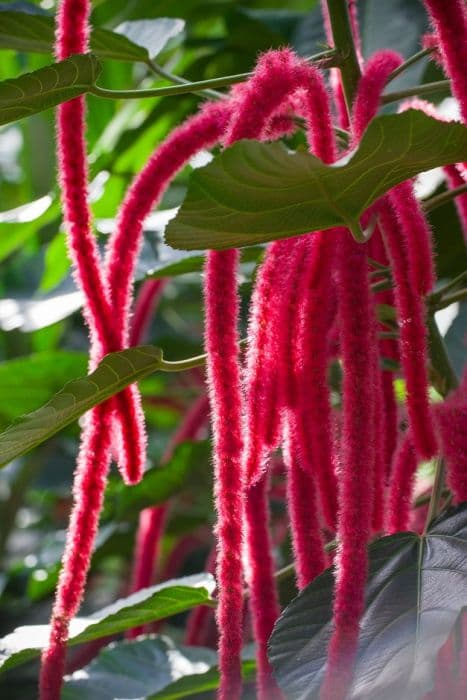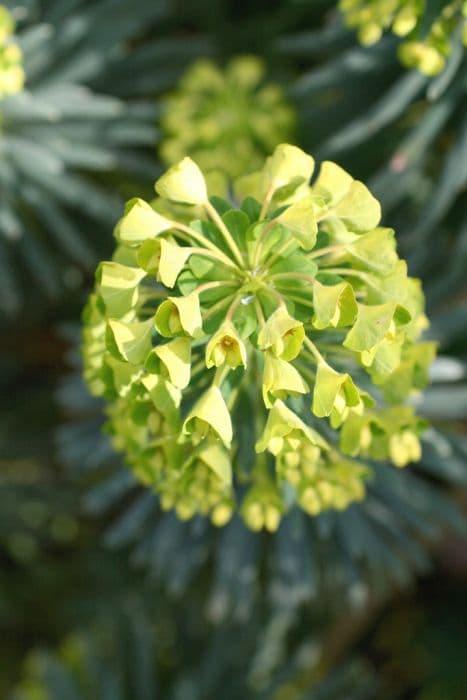Castor bean Ricinus communis 'Carmencita'

ABOUT
Ricinus communis 'Carmencita', commonly known as the castor oil plant, showcases a striking appearance with its distinctive foliage and seed pods. The leaves are star-shaped, glossy, and can range from deep green to a dramatic reddish-purple hue, creating a tropical look. Each leaf sports typically 5 to 11 pointed lobes that radiate from a central point, giving the plant a palm-like aspect. When sunlight filters through the leaves, the color can look especially vibrant. The plant also features unique spiny seed pods that transition from green to a red or bronze color as they mature. These pods contain the seeds that are known for producing castor oil. The flowers of 'Carmencita' are small and lack petals, often overshadowed by the bold foliage and dramatic seed pods. The male and female flowers are clustered separately on the same plant, with the male flowers appearing as yellowish-green clusters beneath the red-tinged female blooms. Overall, Ricinus communis 'Carmencita' is praised for its ornamental value in gardens due to its showy leaves and interesting seed pods.
About this plant
 Names
NamesFamily
Euphorbiaceae
Synonyms
Castor Bean, Castor Oil Plant, Palma Christi, Castor
Common names
Ricinus communis, Ricinus sanguineus, Ricinus viridis, Ricinus africanus, Ricinus angulatus, Ricinus armatus, Ricinus atropurpureus, Ricinus badius, Ricinus borboniensis, Ricinus cambodgensis, Ricinus communis var. africana, Ricinus digitatus, Ricinus europaeus, Ricinus glaucus, Ricinus hybridus, Ricinus inermis, Ricinus japonicus, Ricinus laevis, Ricinus leucocarpus, Ricinus lividus, Ricinus macrophyllus, Ricinus medicus, Ricinus megalospermus, Ricinus minor, Ricinus nanus, Ricinus odoratus, Ricinus peltatus, Ricinus perennis, Ricinus persicus, Ricinus purpurascens, Ricinus rugosus, Ricinus sanguineus, Ricinus scaber, Ricinus speciosus, Ricinus tunisensis, Ricinus viridis, Ricinus zanzibarensis, Ricinus zeylanicus.
 Toxicity
ToxicityTo humans
The castor bean plant contains ricin, a highly toxic compound that can be fatal to humans when ingested. Even a small amount of ricin can lead to poisoning. Symptoms of castor bean poisoning can include nausea, vomiting, diarrhea, abdominal pain, and can lead to severe dehydration. Ingestion can also cause damage to internal organs and can lead to death if not treated promptly.
To pets
Similar to its effects on humans, the castor bean plant is highly toxic to pets due to the presence of ricin. If ingested by animals, it can cause symptoms like vomiting, diarrhea, excessive thirst, weakness, and loss of appetite. This can progress to severe dehydration, tremors, seizures, and organ failure. Immediate veterinary attention is crucial as ricin poisoning can be fatal to pets.
 Characteristics
CharacteristicsLife cycle
Annuals
Foliage type
Deciduous
Color of leaves
Red
Height
8 feet (2.44 meters)
Spread
3 feet (0.91 meters)
Plant type
Shrub
Hardiness zones
9
Native area
Africa
Benefits
 General Benefits
General Benefits- Ornamental Value: The Ricinus communis 'Carmencita', commonly known as Castor Oil Plant, has striking foliage and bold, ornamental seed pods that add visual interest to gardens.
- Drought Tolerance: Once established, it is relatively drought-resistant, making it suitable for xeriscaping or gardens in arid climates.
- Fast Growth: Castor Oil Plant typically grows quickly, which can provide rapid coverage or fill in garden spaces efficiently.
- Erosion Control: Its robust root system can help stabilize soil and prevent erosion on slopes or in areas prone to soil degradation.
- Wildlife Attraction: The flowers of the Castor Oil Plant can attract pollinators such as bees, aiding the pollination of nearby plants.
- Sunscreen: With its dense canopy, it can provide shade for more delicate plants or create cooler areas in the garden.
- Privacy Screen: Due to its height and foliage density, it can be used as a natural privacy screen or windbreak.
- Soil Improvement: When used as green manure or incorporated into the soil, it can contribute organic matter and improve soil fertility over time.
 Medical Properties
Medical Properties- Laxative: The oil extracted from castor seeds is known for its strong laxative properties.
- Topical anti-inflammatory: When applied to skin, castor oil can have anti-inflammatory effects.
- Immune system stimulant: Castor oil is believed to boost the immune system by increasing white blood cells.
- Anti-microbial: It has been suggested that castor oil has properties that can help fight bacterial, viral, and fungal infections.
- Moisturizing agent: Castor oil's rich content can help in skin moisturization and is used in several cosmetic products.
- Antidote for poison: In traditional medicine, the plant has been used as a treatment for various types of poisoning.
- Inducing labor: Castor oil has been historically used to induce labor, although this practice is not generally recommended without medical supervision.
 Air-purifying Qualities
Air-purifying QualitiesThis plant is not specifically known for air purifying qualities.
 Other Uses
Other Uses- Ricinus communis 'Carmencita', commonly known as castor bean, can be used as a natural mole repellent; the moles are deterred by the plant's root system.
- The seeds from the castor bean plant are used to make castor oil, which serves as a lubricant for industrial machinery due to its high viscosity and stability under a wide range of temperatures.
- Castor bean plants are often planted as a part of landscape design for bioengineering purposes, primarily for erosion control due to their extensive root systems.
- After oil extraction, the remaining seed cake is utilized as a high-nitrogen fertilizer which works effectively due to its rich nutrient content.
- Due to their dramatic foliage, castor bean plants are cultivated for use in movie sets and theatre productions to create a tropical or exotic backdrop.
- The stem of the castor bean plant can be processed to produce a biodegradable plastic that provides an alternative to conventional plastics.
- With their attractive leaves and fast growth, castor bean plants are used in emergencies for reforestation and recovery of degraded lands as they help in establishing vegetation quickly.
- The plant's ability to absorb and transpire a large amount of water can be harnessed for phytoremediation to clean up wastewater or polluted soils.
- As a companion plant, castor bean can help protect vegetable gardens by attracting beneficial pollinators while repelling certain pests with its strong scent.
- Artists sometimes use the castor bean's large and ornamental leaves for botanical printmaking due to their interesting textures and patterns.
Interesting Facts
 Feng Shui
Feng ShuiThe Castor Bean plant is not used in Feng Shui practice.
 Zodiac Sign Compitability
Zodiac Sign CompitabilityThe Castor Bean plant is not used in astrology practice.
 Plant Symbolism
Plant Symbolism- Protection: Ricinus communis, commonly known as the castor bean plant, is often associated with protection due to its potent seeds that were historically used in folk magic for guarding against negative energy.
- Healing: The castor oil derived from the plant has been used medicinally for centuries, symbolizing the castor bean plant's association with healing and wellness.
- Purification: In some cultures, the castor bean plant represents purification as the oil was believed to cleanse the body and spirit of toxins.
- Cautiousness: Given the toxicity of the seeds when ingested, the castor bean plant can symbolize the need for caution and the importance of recognizing potential danger.
 Water
WaterThe Castor Bean plant should be watered when the top inch of soil feels dry to the touch, which is typically once a week during active growth in warmer months. The amount of water needed should be enough to soak the soil deeply; this could amount to roughly 0.5-1 gallon for outdoor plants, depending on the size of the plant and environmental conditions. It's important to avoid over-watering, as standing water can lead to root rot. During winter months or when the plant is dormant, reduce watering frequency to every other week or less, based on soil moisture levels.
 Light
LightCastor Bean plants thrive in full sun where they can receive at least six hours of direct sunlight daily. The ideal spot for a Castor Bean plant is in a position where the intense midday sun can promote vigorous growth and flowering. However, in extremely hot climates, light afternoon shade is beneficial to prevent scorching of the leaves.
 Temperature
TemperatureCastor Bean plants prefer warm temperatures, typically between 60°F and 85°F. They can withstand temperatures up to 100°F as long as they are properly watered. Frost and temperatures below 32°F can be harmful and even fatal to the plants, therefore they should be grown in areas where frost is not a concern or provided with protection if cold temperatures are expected.
 Pruning
PruningPruning Castor Bean plants is usually not necessary unless you want to shape the plant or maintain a certain size. The best time to prune is in late winter or early spring before new growth begins. Remove any dead or damaged stems to maintain plant health and appearance. Pruning can be done once a year or as needed.
 Cleaning
CleaningAs needed
 Soil
SoilCastor bean 'Carmencita' thrives in a soil mix that is rich, slightly acidic to neutral, with a pH of 6.0 to 7.0. A combination of loamy soil, compost, and perlite or sand to ensure good drainage is ideal for this plant.
 Repotting
RepottingCastor bean plants generally do not need frequent repotting as they are fast-growing and often treated as annuals. If grown as perennials, repot young plants yearly or when root bound.
 Humidity & Misting
Humidity & MistingCastor bean 'Carmencita' prefers moderate to high humidity levels but is quite adaptable and can tolerate lower humidity without adverse effects.
 Suitable locations
Suitable locationsIndoor
Ensure bright light, warmth, and space for growth.
Outdoor
Plant in full sun, shelter from strong winds.
Hardiness zone
9-11 USDA
 Life cycle
Life cycleCastor Bean 'Carmencita' begins its life as a seed, which, when planted in warm, moist soil, will germinate usually within 1-2 weeks. After germination, the seedling emerges, unfurling distinctive reddish-purple leaves that continue to develop as the plant enters the vegetative growth stage. During this stage, the plant grows rapidly, forming a tall, sturdy stem and a canopy of large, palmate leaves. After reaching maturity which can take several months, Castor Bean 'Carmencita' produces flower clusters (inflorescences) containing both male and female flowers, leading to pollination and seed development. The pollinated flowers then develop into spiny seed pods that dry and split open when ripe, releasing the seeds for dispersal. Once seeds are dispersed, the annual plant completes its life cycle and dies, although in tropical climates where it can be a perennial, it may live for several years.
 Propogation
PropogationPropogation time
Spring-Early Summer
The most popular method of propagating the castor bean plant (Ricinus communis 'Carmencita') is by seed. Propagation time is typically in the spring after the last frost, when soil temperatures have warmed sufficiently. To propagate, seeds should be sown directly into the ground or into pots filled with well-draining soil. Soak the seeds for 24 hours in water to help soften the tough outer shell, which can enhance germination rates. Sow seeds about 1 inch deep (about 2.5 centimeters) and space them at least 18 inches (approximately 45 centimeters) apart to accommodate the mature size of the plants. Seeds usually germinate within 10 to 21 days. Given the toxic nature of Ricinus seeds, caution should be taken to avoid ingestion or handling by children and pets.









